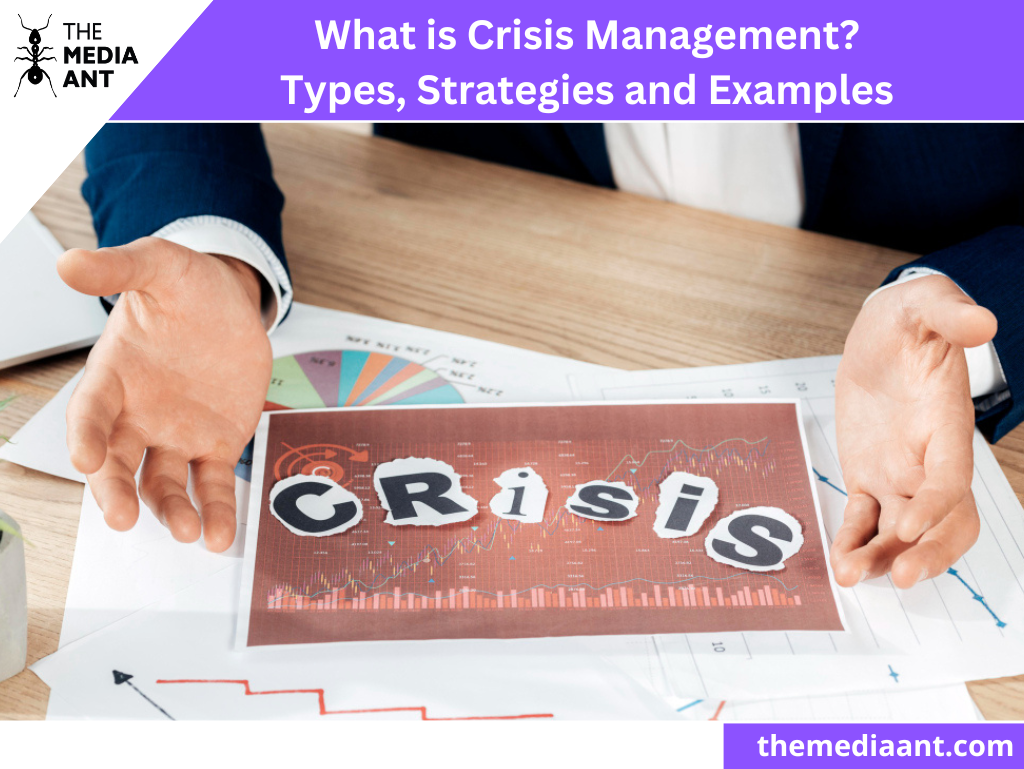“Ever heard the saying, ‘Expect the unexpected’? In both the business world and beyond, this saying holds especially true when dealing with crises. Whether it’s a sudden PR nightmare that’s trending on every social media platform, a supply chain disruption that threatens your production, or a cybersecurity breach that leaves your digital front door wide open – crises can strike without warning, leaving you scrambling to stay afloat. But fear not, for amid chaos, there’s a lifeline: effective crisis management strategies. Think of them as your emergency toolkit, your guide to not only weathering the storm but also using it as an opportunity to showcase your organization’s resilience.
So, grab a seat as we delve into the world of crisis management – a world where preparation meets opportunity, and where the unexpected becomes the catalyst for your comeback story.”
What is Crisis Management?
Crisis management refers to the strategic process of preparing for, responding to, and recovering from significant and unexpected events that could harm an organization’s reputation, operations, stakeholders, or overall well-being. These events, known as crises, can include natural disasters, technological failures, public relations incidents, financial disruptions, accidents, cybersecurity breaches, and more.
The primary goal of crisis management is to mitigate the negative impact of a crisis on an organization and its stakeholders. This involves effectively managing the situation to minimize damage, restore normalcy, and maintain or rebuild the organization’s reputation. Crisis management encompasses various strategies and actions designed to address the immediate challenges of the crisis while also considering long-term consequences.
Key components of crisis management
Prevention and Preparation: Identifying potential risks and vulnerabilities, conducting risk assessments, and developing contingency plans to be ready for a variety of crisis scenarios.
Response: Quickly assessing the situation, activating a designated crisis response team, and implementing pre-defined protocols and procedures to manage the crisis as effectively as possible.
Communication: Developing clear and transparent communication strategies for both internal and external stakeholders, ensuring accurate and consistent messaging to manage perceptions and expectations.
Adaptability: Being flexible and adaptable to changing circumstances, as crises often evolve rapidly and unpredictably.
Learning and Improvement: Analyzing the crisis response after the situation has been resolved to identify lessons learned and areas for improvement in future crisis management efforts.
Recovery and Rebuilding: Developing plans and strategies to restore operations, rebuild trust with stakeholders, and recover any losses incurred during the crisis.
Effective crisis management requires a combination of leadership, communication skills, strategic thinking, and collaboration. Organizations that are well-prepared and have a robust crisis management strategy in place are better equipped to navigate challenging situations and emerge from crises with their reputation and operations intact.
A crisis management plan is a document that outlines the organization’s policies and procedures for responding to a crisis. The plan should include the following:
- A list of potential crises that the organization could face.
- An assessment of the likelihood of each crisis occurring.
- Plans to respond to each crisis.
- A list of contact information for key stakeholders.
- A communication plan.
- A business continuity plan.
- A crisis recovery plan.
Crisis Management V/s Risk Management
Crisis management and Risk management are two closely related concepts, but they are not the same thing.
Risk management is the process of identifying, assessing, and mitigating risks to an organization. It is a proactive approach to preventing problems before they happen.
Crisis management is the process of responding to a disruptive and unexpected event that threatens to harm an organization or its stakeholders. It is a reactive approach to dealing with problems after they have happened.
Here is a table that summarizes the key differences between crisis management and risk management:
| Crisis Management | Risk Management |
| Reactive | Proactive |
| Responds to a problem after it has happened | Prevents problems from happening |
| Focuses on damage control | Focuses on prevention |
| Takes place during a crisis | Takes place before a crisis |
Here are some examples of risks that can be managed through risk management:
Financial risk: The risk of losing money due to economic downturn, market fluctuations, or fraud.
Operational risk: The risk of losses due to human error, system failures, or natural disasters.
Reputational risk: The risk of damage to an organization’s reputation due to negative publicity, product recalls, or other incidents.
Here are some examples of crises that can be managed through crisis management:
- Product recalls
- Data breaches
- Natural disasters
- Workplace violence
- Public relations disasters
Both crisis management and risk management are important for organizations. By taking a proactive approach to risk management, organizations can reduce the likelihood of a crisis happening. By having a crisis management plan in place, organizations can minimize the damage caused by a crisis if it does happen.
Stages of a Crisis Management
In the realm of crisis management, understanding the distinct stages a crisis unfolds can be pivotal in crafting a strategic response. While these stages manifest organically during a crisis, having a robust crisis management plan in place beforehand is essential.
1. Warning
Although you cannot always predict the timing or occurrence of a crisis, there are often signs you can look for that serve as a warning. These warning signs can be related to a wide range of factors such as an employee’s behavior, weather patterns, or company finances.
2. Risk Assessment
The risk assessment stage begins immediately after a crisis starts to unfold. It’s when the key players at your company begin assessing the impact the situation might have on your business, employees, and customers.
During this stage, the potential ramifications of the crisis, plausible damages, and resulting problems are discussed. This way, everyone involved is prepared for the worst possible scenario.
3. Response
Once you review the level of risk associated with the crisis, you and your team will be able to decide which crisis management plan you want to implement. Then, everyone involved — including your employees, customers, and emergency response teams (if necessary) — can be notified of the situation.
The response stage involves a lot of communication to both inform everyone of the crisis and kickstart the various actions that will be taken to manage and mitigate the incident.
4. Management
Next comes the management phase. This is when everyone involved in rectifying the crisis comes forward to work on managing the chosen resolution plan, the immediate effects of the event, and any new or worsening effects that arise.
This stage involves the same type of open communication that you used in the response phase to ensure all employees, customers, and stakeholders are up to speed on the state of the business.
5. Resolution
During this phase, everyone involved in the resolution of the crisis should have fulfilled (or nearly fulfilled) their given duties. The crisis should be pretty much under control at this point. It’s also when all of the necessary plans and actions that will be used to return your business to normalcy are initiated.
6. Recovery
As you leave the resolution phase and move into recovery, your resolution plans are well underway and your business is getting back on track. This stage includes getting all employees back into their day-to-day operations and ensuring customers are set up for success with your products once again.
It’s very important to analyze the results of your crisis management plan during the recovery phase as well. This way you can determine how you feel the situation was managed and how you plan to avoid another similar situation from happening in the future.
Effective Crisis Management Strategies
Crises can strike unexpectedly, testing an organization’s resilience and reputation. Implementing effective crisis management strategies is essential to mitigate the impact and maintain trust. Here are key strategies to navigate a crisis successfully:
Preparation is Key:
Develop a Comprehensive Plan: Craft a well-defined crisis management plan outlining roles, responsibilities, communication protocols, and escalation procedures.
Simulate Scenarios: Conduct regular crisis simulations and tabletop exercises to prepare your team for real-time crisis response.
Establish a Crisis Team:
Assemble the Right Team: Form a cross-functional crisis management team comprising senior leaders, communication experts, legal counsel, and relevant stakeholders.
Define Roles: Clearly define each team member’s responsibilities and decision-making authority during a crisis.
Clear Communication:
Rapid and Transparent Messaging: Communicate promptly, providing accurate and transparent information to internal and external stakeholders.
Unified Voice: Ensure consistent messaging across all communication channels to avoid confusion and misinformation.
Adaptability and Flexibility:
Agile Decision-Making: Be prepared to make swift decisions as the situation evolves, adjusting strategies based on new information.
Scenario Planning: Develop multiple response strategies to cater to different crisis developments.
Stakeholder Engagement:
Empathy and Support: Show genuine concern for affected stakeholders and provide assistance where needed.
Address Concerns: Address questions and concerns promptly to prevent rumors and speculation.
Media Management:
Designated Spokesperson: Appoint a spokesperson to interact with the media and deliver consistent messages.
Monitoring and Response: Monitor media coverage and social media discussions to counter misinformation and manage the narrative.
Digital Presence:
Social Media Strategy: Utilize social media platforms to disseminate accurate information and engage with stakeholders in real time.
Online Reputation Management: Monitor online sentiment and address negative commentary promptly.
Learn and Adapt:
Post-Crisis Evaluation: Analyze the crisis management process, identifying strengths and areas for improvement.
Incorporate Lessons: Update your crisis management plan based on the lessons learned from each crisis.
Legal and Regulatory Compliance:
Consult Legal Experts: Ensure all crisis responses adhere to legal and regulatory requirements.
Protect Data and Privacy: Safeguard sensitive information while complying with data protection regulations.
Crisis Recovery and Continuity:
Rebuild Trust: Implement actions to rebuild trust and reputation among stakeholders.
Business Continuity Planning: Develop strategies to resume normal operations swiftly after the crisis.
By implementing these crisis management strategies, organizations can effectively navigate turbulent times, minimize damage, and emerge stronger with their reputation intact.
Case Studies on Crisis Management
Nestle’s Maggi Noodles ban in India
In 2015, Nestle India, the Indian subsidiary of Swiss multinational food and beverage company Nestle, was forced to recall its Maggi noodle brand from the market after tests by food safety regulators found that the noodles contained excessive levels of lead. The recall was a major blow to Nestle India, which had been selling Maggi noodles in the country for over 30 years.
The lead controversy began in May 2015, when the Food Safety and Standards Authority of India (FSSAI) tested Maggi noodles from several states and found that the lead content in the noodles exceeded the permissible limit of 2.5 parts per million (ppm). The FSSAI then ordered a nationwide recall of Maggi noodles.
Nestle India initially denied the allegations, but it later recalled the noodles from the market. The company also set up a task force to investigate the matter. The task force’s report, released in June 2015, found that the lead content in Maggi noodles was indeed excessive.
The lead controversy had a significant impact on Nestle India. The company’s share price fell sharply, and it lost market share to its competitors. Nestle India also faced a number of legal challenges. In July 2015, the Uttar Pradesh government filed a criminal case against Nestle India for selling food products that were unsafe for human consumption.
In August 2015, the FSSAI banned the sale of Maggi noodles in India. The ban was lifted in November 2015, after Nestle India agreed to make changes to the manufacturing process of Maggi noodles. However, the company’s reputation had been damaged, and it has been slow to recover.
The Maggi ban case study is a cautionary tale about the importance of food safety. It also highlights the challenges that multinational companies face when operating in emerging markets.
Here are some of the key lessons that can be learned from the Maggi ban case study:
- Food safety is of paramount importance. Companies must ensure that their products are safe for human consumption.
- Companies must comply with all applicable food safety regulations.
- Companies must be transparent and responsive when food safety issues arise.
- Companies must be prepared to face the consequences of food safety violations, including legal action and financial losses.
How Maggi Made a Comeback?
All throughout the ban when Maggi was striving hard to be back on shelves, the instant noodles brand never closed the doors of communication with its consumers. In fact, it serenaded them with tribute videos showing gratitude to its fans that were heavy on storytelling and emotional overtones.
Maggi had been systematically rolling out films in each phase of its ban status. It also ensured to address varied consumer segments in its video series – young boys and girls living in hostels, bachelors to the Indian moms who’ve been making Maggi for their kids ever since it’s been there.
Nestle India had rolled out a series of short films hashtagged #WeMissYouToo when it waited for the test results. Dedicated to all the fans who supported and stood by the brand, there was a Maggi fanboy/fangirl in each of the videos, who badly missed their favorite noodle. They are seen making a plea to Maggi, as if it were their long lost friend – “Come back, man!”, “Abb aa bhi jao”, “kabb wapas aayega yaar?”, “We miss you Maggi“.
The Maggi ban case study is a reminder that food safety is a serious issue that companies cannot afford to take lightly. Companies must take steps to ensure that their products are safe for human consumption, and they must be prepared to face the consequences if they violate food safety regulations.
Cadbury’s Worm Controversy
In October 2003, just a month before Diwali, the Hindu festival of lights, the Food and Drug Administration (FDA) of India received complaints about the infestation of worms in two bars of Cadbury Dairy Milk, Cadbury India’s flagship brand with over 70% market share. The FDA immediately ordered an investigation and seized the chocolate stocks manufactured at Cadbury’s Pune plant.
Cadbury India initially denied the allegations, but it later admitted that there was a possibility that the worms could have entered the chocolate during the transportation or storage process. The company also launched a massive recall of all its products manufactured in the Pune plant.
The worm controversy had a significant impact on Cadbury India. The company’s sales fell by 30%, and its market share dropped to 50%. The company also faced a number of legal challenges, including a class-action lawsuit filed by consumers.
Cadbury India’s crisis management was initially criticized for being slow and inadequate. However, the company eventually turned things around by taking the following steps:
- Appointing a new CEO who had a strong track record in crisis management.
- Launching a comprehensive advertising campaign to reassure consumers about the safety of its products.
- Investing in new manufacturing facilities and quality control measures.
- As a result of these efforts, Cadbury India was able to recover from the worm controversy and regain its market share.
The Cadbury worm controversy is a reminder that even the most well-known and respected brands can be vulnerable to food safety problems. Companies must be vigilant in their food safety practices and be prepared to respond quickly and effectively to any problems that arise.
Conclusion
In the face of uncertainty, mastering effective crisis management strategies becomes an organizational imperative. As this blog has delved into the multifaceted world of crisis management, it is evident that preparation, quick response, clear communication, adaptability, and a commitment to continuous improvement are the cornerstones of a successful crisis management approach. By cultivating a culture of readiness and equipping your team with the right tools, organizations can not only weather the storm but also emerge stronger and more resilient.
Remember, a crisis doesn’t define an organization; rather, it is the organization’s response that shapes its legacy. In the ever-evolving landscape of business, the ability to navigate crises with poise and efficacy is a testament to an organization’s leadership, values, and commitment to its stakeholders’ well-being.






Your blog is interesting. Crisis management strategies are essential for brands to remain trustworthy.